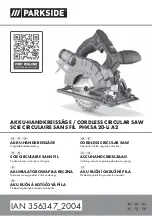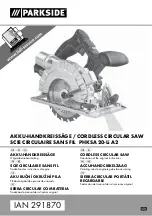
8
9
Fig. 7
6. Always allow blade to come to a full stop before
removing the saw from the workpiece. Never
remove the saw from a cut while the blade is
moving. If restarting or correcting direction in
mid-cut, allow blade to coast to a stop, back saw
up a few inches and center it in the kerf before
restarting.
7. Stay alert. Any distraction can cause twisting or
binding. Repetitive cuts may lull the user into
careless movements.
8. Use care when making bevel cuts. Because of
the increased amount of blade engagement with
the work and decreased stability of the shoe when
making bevel cuts, kickback may occur if improp-
erly used. Keep shoe
fi
rmly against workpiece.
Fig. 8
Fig. 9
Tighten depth and miter
adjusting levers securely
Set depth of cut
1/8"-1/4" greater
than thickness
of stock
Rest saw on
larger part of
workpiece,
allowing
smaller part
to fall away
Secure workpiece
to sturdy supports
Firm footing
in clean area
Keep cord
away from
blade and
kerf
No loose
clothing
Wear safety
goggles
Grip saw with both hands,
keeping hands away from
blade
3. While cutting, keep shoe
fl
at against workpiece
and maintain a
fi
rm grip. Do not force saw through
the work. Forcing a saw can cause kickback.
4. If making a partial cut, restarting in mid-cut or
correcting direction, allow blade to come to a
complete stop. To resume cutting, center blade
in kerf, back saw away from cutting edge a few
inches, pull trigger and re-enter cut slowly.
5. If saw stalls, maintain a
fi
rm grip and release
trigger immediately. Correct problem before
continuing (see “Preventing Kickback”).
6. After
fi
nishing a cut, be sure lower guard closes
and blade comes to a complete stop before set-
ting down saw.
Troubleshooting
If blade does not want to follow straight line:
• Teeth are dull on one side. This is caused by
hitting a hard object such as a nail or stone,
dulling teeth on one side. The blade wants to
cut to the side with the sharpest teeth.
• Shoe is out of line or bent
• Blade is bent
• Failure to use rip fence or guide
If blade binds, smokes, or turns blue from friction:
• Blade is dull
• Blade is on backwards
• Blade is bent
• Blade is dirty
• Workpiece is not properly supported
• Failure to use correct blade
APPLICATIONS
WARNING
To reduce the risk of elec-
tric shock, check work area for hidden pipes
and wires before making plunge cuts.
Cutting Large Panels
Large panels and long boards sag or bend if they
are not correctly supported. If you attempt to cut
without leveling and properly supporting the piece,
the blade will tend to bind, causing kickback.
Support large panels. Be sure to set the depth of
cut so that you cut through workpiece only and not
through the supports.
Fig. 10
Ripping Wood
Ripping is cutting lengthwise with the grain. Select
the proper blade for your job. Use a rip fence for
rips 4" wide or less. To install a rip fence, slide
the bar through the rip fence slot in either side of
the shoe. Adjust for desired width by lining up the
selected measurement with the sighting notch and
lock setting with thumb screw.
When ripping widths greater than 4", clamp or tack
1" lumber to the workpiece as a guide.
Cross-Cutting Wood
Cross-cutting is cutting across the grain. Select the
proper blade for your job. Advance saw slowly to
avoid the tendency of wood
fi
bers to tear and lift.
Pocket Cutting
Pocket cuts are made in the middle of the work-
piece when it can not be cut from an edge. We
recommend using a Sawzall
®
for this type of cut.
However, if you must use a circular saw to make a
pocket cut, USE EXTREME CAUTION.
1. Beginning at a corner, line up sighting notch with
your cutting line. Tilt saw forward,
fi
rmly
fi
front of shoe on workpiece. Blade should be
just above cutting line, but not touching it. Raise
lower guard using lower guard lever.
9. Do not force tool. Forcing a saw reduces control
and cutting ef
fi
ciency.
10.Use rip fence or edge guide when ripping. Guides
improve control and reduce blade binding (see
“Ripping Wood”).
If kickback should occur, continue to grip the saw
fi
rmly and immediately release trigger.
General Operation
Always clamp workpiece securely on a saw horse
or bench. See “Applications” for the correct way to
support your work in different situations. A typical
application is shown below.
1. Draw cutting line. Place front of shoe on edge of
workpiece without making blade contact. Hold
switch handle with one hand and top handle with
the other.
2. Line up sighting notch with your cutting line.
Position arms and body to resist kickback. Pull
trigger, allowing motor to reach full speed before
beginning cut.
3. When shoe rests
fl
at against workpiece (Fig. 12),
move saw to far corner. Release trigger and
allow blade to come to a complete stop before
removing it from workpiece. Repeat the above
steps for each side of the opening. Use a Saw-
zall
®
, jig saw, or small hand saw to
fi
nish corners
if they are not completely cut through.
2. Pull trigger. Allow the blade to come to full speed.
Using front of shoe as a hinge point, gradually
lower back end of saw into workpiece (Fig. 11).
Fig. 11
Fig. 12





































